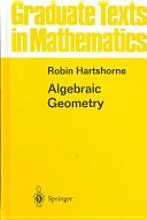
Springer GTM 52.
"This book provides an introduction to abstract algebraic geometry using the methods of schemes and cohomology."
Exercise Solutions Available:
- www.lomont.org/Math/Solutions.pdf
- http://algebraicgeometry.blogspot.com/
- http://www.math.mcgill.ca/bcais/CourseNotes/AlgGeom04/Hartshorne_Solutions.pdf
- www.math.jhu.edu/.../Hartshorne%20Algebraic%20Geometry%20Solutions.pdf
- http://mathsci.kaist.ac.kr/~jinhyun/sol2/hart.html
- nicf.net/math/rh-IV12.pdf
- http://en.wikibooks.org/wiki/Solutions_to_Hartshorne%27s_Algebraic_Geometry
Chapter I: Varieties[]
Section I.1: Affine Varieties[]
- Height of a prime ideal: Height of a prime ideal is like codimension of a subvariety.
- Proposition I.1.10: because and .
- Exercise I.1.1:http://math.stackexchange.com/questions/69015/exercise-in-hartshorne,http://math.stackexchange.com/questions/100906/hartshorne-exercise-1-1-a
Section I.2: Projective Varieties[]
- Exercise I.2.14: http://math.stackexchange.com/questions/353846/hartshorne-problem-1-2-14-on-segre-embedding
Section I.3: Morphisms[]
- Exercise I.3.7: http://math.stackexchange.com/questions/699433/exercise-3-7-hartshorne
- Exercise I.3.8: http://math.stackexchange.com/questions/860577/hartshorne-exercise-1-3-8
- Exercise I.3.13: http://math.stackexchange.com/questions/124422/local-ring-of-a-subvariety-problem-1-3-13-in-hartshorne
Section I.4: Rational Maps[]
- Exercise I.4.8: http://mathoverflow.net/questions/76174/hartshornes-exercise-i-4-8-any-two-curves-over-k-homeomorphic
Section I.5: Nonsingular Varieties[]
- One can show easily that [the Jacobian] definition of nonsingularity is independent of the choice of generators of the ideal: The point is that what we're really calculating is the dimension of the space spanned by the vectors for each . Suppose that and ; then for some , and so we have . Since and , we have by definition, so this reduces to . Clearly, then, the vector lies in the span of the vectors for .
- Example I.5.6: We need an additional commutative algebra result not found in the chapter to make sense of this, namely that , where . See Chapter 7 of Eisenbud - Commutative Algebra - with a View Toward Algebraic Geometry.
- Exercise I.5.1: http://math.stackexchange.com/questions/331876/do-the-pictures-in-hartshorne-ex-1-5-1-make-sense
- Exercise I.5.2: http://math.stackexchange.com/questions/961889/definition-of-intersection-multiplicity-in-hartshorne-vs-fulton-for-plane-curves
Section I.6: Nonsingular Curves[]
Section I.7: Intersections in Projective Space[]
Section I.8: What is Algebraic Geometry?[]
Chapter II: Schemes[]
Section II.1: Sheaves[]
- Exercise II.1.16(b): http://math.stackexchange.com/questions/1025910/hartshorne-ex-ii-1-16-b-flasque-sheaves-and-exact-sequences
- Exercise II.1.18: http://math.stackexchange.com/questions/1000044/maps-between-direct-limits-and-functoriality-of-f-1shvy-rightarrow-shvx
- Exercise II.1.21: http://math.stackexchange.com/questions/35490/hartshorne-exercise-about-sheaves-on-mathbbp1
Section II.2: Schemes[]
- Proposition II.2.6: http://math.stackexchange.com/questions/240477/question-of-hartshorne-books-proposion-ii-2-6
- Exercise II.2.13: http://math.stackexchange.com/questions/57024/quasi-compact-and-compact-in-algebraic-geometry
- Exercise II.2.18(b): http://math.stackexchange.com/questions/424884/possible-mistake-in-exercise-in-hartshorne-exercise-ii-2-18b
Section II.3: First Properties of Schemes[]
- Proposition II.3.1: Then which is not an integral domain. A product of nontrivial rings can never be an integral domain: (a, 0) * (0, b) = (0, 0), so (a, 0) and (0, b) are zero divisors. (In some sense it seems like Proposition 3.1 is a partial converse to this.)
- Proposition II.3.2: http://math.stackexchange.com/questions/55825/an-isomorphism-problem-in-scheme-while-reading-hartshorne
- Exercise II.3.1: http://math.stackexchange.com/questions/803636/question-on-morphism-locally-of-finite-type
- Example II.3.2.4: http://math.stackexchange.com/questions/297123/some-question-of-schemehartshorne-exampleii-3-2-4
- Exercise II.3.18: http://math.stackexchange.com/questions/1001237/hartshorne-exercise-3-18-chapter-2
- Exercise II.3.19: http://math.stackexchange.com/questions/259609/hartshorne-exercise-ii-3-19-a, http://math.stackexchange.com/questions/259117/hartshorne-exercise-ii-3-19-b, http://math.stackexchange.com/questions/261114/hartshorne-exercise-ii-3-19-c
- Exercise II.3.20: http://math.stackexchange.com/questions/921764/exercise-3-20-in-hartshorne-on-dimension-of-integral-schemes-of-finite-type-over
Section II.4: Separated and Proper Morphisms[]
Section II.5: Sheaves of Modules[]
- Proposition II.5.4: http://math.stackexchange.com/questions/52856/is-noetherian-condition-always-needed-when-speaking-of-a-coherent-sheaf
- Proposition II.5.13: http://math.stackexchange.com/questions/313752/hartshorne-book-proposition-ii-5-13
- Exercise II.5.7: http://math.stackexchange.com/questions/967012/hartshorne-chapter-ii-exercise-5-7-on-invertible-sheaves
- Exercise II.5.9: http://mathoverflow.net/questions/19105/question-on-an-exercise-in-hartshorne-equivalence-of-categories
- Exercise II.5.13: http://math.stackexchange.com/questions/58470/proj-of-graded-rings
- Exercise II.5.18(d): http://math.stackexchange.com/questions/822731/exercise-5-18d-chapter-2-hartshorne
Section II.6: Divisors[]
- Page 129: For each line L in P^2, we consider which is a finite set of points on C. Note that the "points" mentioned here are intrinsic points of C, not points of P^2 on the embedded copy of C.
- Proof of Proposition II.6.2: It is well-known that a UFD is integrally closed. This is a consequence of the rational root theorem.
- Example II.6.5.2: http://math.stackexchange.com/questions/241666/example-6-5-2-p-133-in-hartshorne, http://math.stackexchange.com/questions/326509/a-question-on-generic-point-and-a-question-on-hartshorne
- Proposition II.6.5: http://math.stackexchange.com/questions/388724/hartshorne-proposition-ii-6-5
- Page 141: http://math.stackexchange.com/questions/223773/functional-sheaf-hartshorne-cartier-divisors
- Exercises II.6.11-12: http://math.stackexchange.com/questions/869796/torsion-sheaves-on-a-curve
Section II.7: Projective Morphisms[]
Section II.8: Differentials[]
- Page 172: http://math.stackexchange.com/questions/410881/sheaf-of-differential-forms-tangent-sheaf-hartshorne, http://mathoverflow.net/questions/132718/sheaf-of-differential-forms-tangent-sheaf-hartshorne
- Theorem II.8.13: http://math.stackexchange.com/questions/1094953/e-to-s-surjective-in-degrees-geq-1-implies-widetildee-to-widetildes
- Proposition II.8.20: http://math.stackexchange.com/questions/417798/hartshorne-proof-of-adjunction-formula-proposition-ii-8-20
- Example II.8.20.3: http://math.stackexchange.com/questions/83227/image-type-of-the-canonical-divisor-under-the-isomorphism-mathrmpic-mathbb
Section II.9: Formal Schemes[]
Chapter III: Cohomology[]
Section III.1: Derived Functors[]
Section III.2: Cohomology of Sheaves[]
- Proposition III.2.6: http://math.stackexchange.com/questions/447220/hartshornes-weird-definition-of-right-derived-functors-and-prop-iii-2-6/447234#447234
- Exercise III.2.1(a): http://math.stackexchange.com/questions/74641/hartshorne-exercise-iii-2-1a
- Exericse III.2.1(b): http://math.stackexchange.com/questions/910385/showing-grothendiecks-vanishing-theorem-provides-a-strict-bound
Section III.3: Cohomology of a Noetherian Affine Scheme[]
Section III.4: Cech Cohomology[]
Section III.5: The Cohomology of Projective Space[]
Section III.6: Ext Groups and Sheaves[]
- Exercise III.6.2(a): http://math.stackexchange.com/questions/897880/hartshorne-exercise-iii-6-2-a
Section III.7: The Serre Duality Theorem[]
Section III.8: Higher Direct Images of Sheaves[]
Section III.9: Flat Morphisms[]
- III.9.5: http://math.stackexchange.com/questions/430948/base-step-of-induction-in-hartshorne-iii-9-5
- Proposition III.9.8: http://math.stackexchange.com/questions/430766/hartshorne-iii-9-8-understanding-associated-points-and-extensions
- Theorem III.9.9.: https://math.stackexchange.com/questions/2368912/proof-of-theorem-9-9-in-part-iii-of-hartshornes-algebraic-geometry/2370490#2370490
Section III.10: Smooth Morphisms[]
- Exercise III.10.2: http://math.stackexchange.com/questions/830565/hartshorne-ex-iii-10-2-on-smooth-morphisms
Section III.11: The Theorem on Formal Functions[]
Section III.12: The Semicontinuity Theorem[]
- Exercise III.12.3: http://math.stackexchange.com/questions/116601/hartshorne-exercise-iii-12-3
Chapter IV: Curves[]
Section IV.1: Riemann-Roch Theorem[]
- Proof of Theorem IV.1.3: we have an exact sequence
This is an issue that comes up all over the place. It makes sense to talk about k(P), a k-valued skyscraper sheaf supported at P, only when we're thinking about k(P) as a sheaf of rings, like when we're thinking of it as the structure sheaf of P. In the exact sequence above, though, we're regarding it not as a sheaf of rings but as a sheaf of -modules, and in this case writing k(P) isn't that helpful because it doesn't really specify the -module structure. In this case, acts on by . This clarifies why : we can simply move functions on the left over to the right side of the tensor product.
- Proof of Theorem IV.1.3:: Recall that k(P) here really means , where j denotes the inclusion . By Lemma III.2.10, , so it follows that . By Grothendieck vanishing (Theorem III.2.7), a sheaf on the zero-dimensional space P only has zeroth cohomology, so .
- Example IV.1.8: http://math.stackexchange.com/questions/381585/length-of-a-quotient-in-hartshorne-iv-ex-1-8
Section IV.2: Hurwitz's Theorem[]
Section IV.3: Embeddings in Projective Space[]
Section IV.4: Elliptic Curves[]
Section IV.5: The Canonical Embedding[]
Section IV.6: Classification of Curves in P^n[]
Chapter V: Surfaces[]
Section V.1: Geometry on a Surface[]
- Page 357: This implies, by the way, that C and D are each nonsingular at P:
Since the maximal ideal of is generated by f, {f} is a regular system of parameters. Since its cardinality is equal to the Krull dimension , is a regular local ring.







![{\displaystyle p_{i}\in k[x_{1},\ldots ,x_{n}]}](https://services.fandom.com/mathoid-facade/v1/media/math/render/svg/405265f6e2931a4dce623613fdfc9268b4cb5d5b)







![{\displaystyle (k[x_{1},\ldots ,x_{n}]/I)_{\mathfrak {m}}\cong k[[x_{1},\ldots ,x_{n}]]/Ik[[x_{1},\ldots ,x_{n}]]}](https://services.fandom.com/mathoid-facade/v1/media/math/render/svg/423ef95c8a02ce44db1a5750fbac20acd8ab66dd)















